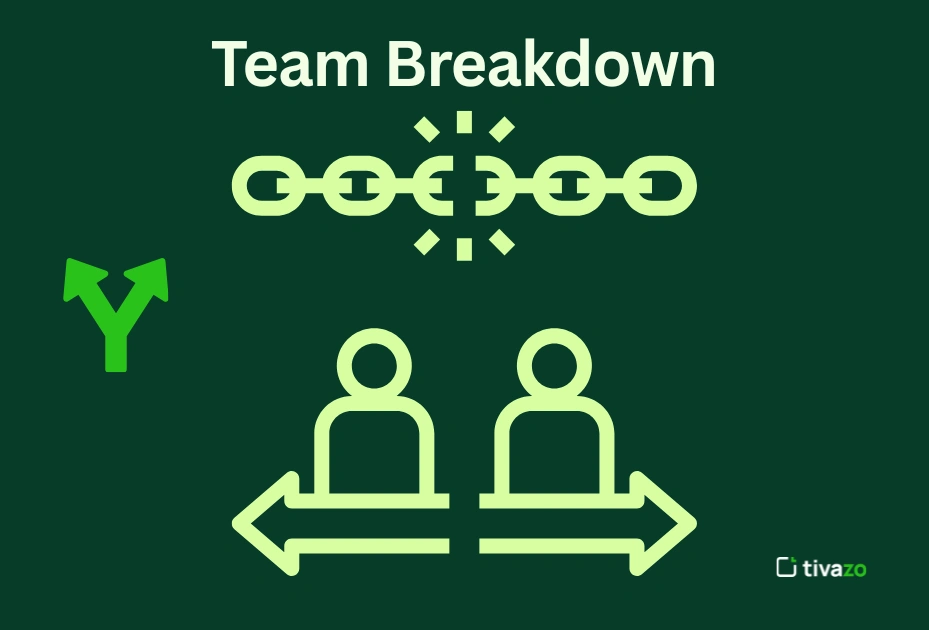Every team experiences highs and lows, but what does it mean when those “lows” seem permanent? If communication breaks down, morale declines, and progress halts, you may be dealing with a team breakdown—a quiet killer of productivity.
In today’s fast-paced workplace, fast-moving teams can break down quickly if you miss the signs. A team breakdown is not always loud or obvious; it sometimes arrives subtly—through missed deadlines, restrained frustration, and building tension.
In this post, you will learn:
- What a team breakdown means
- Why it occurs
- 7 clear warning signs
- Key strategies to recover and rebuild your happy, healthy teams
Let’s get started.
What Is a Team Breakdown?

A team breakdown happens when a team becomes so dysfunctional that communication, collaboration, and performance are negatively impacted. It’s not just one fight or a bad day, this is a pattern of behavior that is impeding the team.
Signs of a team breakdown:
- Heightened tension and conflict
Tension and conflict (whether verbal or unspoken) can create an uncomfortable atmosphere. Over time this tension can fracture relationships and workflows.
- Poor collaboration and communication
Once team members stopped sharing updates, communication stalls and teams start operating as silos – repeating work, creating confusion, and losing out on opportunities which lead to team breakdown.
- Reduced engagement and motivation
A disconnected stance equates to lack of passion or energy. Getting people to participate or addressing emotional disconnection is difficult, as is motivating team members that show up late, and or appear to contribute less during meetings.
- Culture of blaming and avoiding responsibility
People don’t want to admit they’re wrong, so they’ll avoid blame by pointing fingers or blaming others. This particular culture can’t allow people to be accountable, while enabling unhealthy behaviors.
- High turnover or amount of sick days
If you see a lot of people leaving voluntarily or a lot of sick days, it likely means the individual(s) is unhappy/sick. This means there is a deeper problem with overall morale and job satisfaction.
Addressing team breakdown is vital early before it festers, because it is unlikely to fix itself. The longer you let a team deteriorate the worse it will get.
Why Do Team Breakdowns Happen?

When teams breakdown, it is important to understand what has led to the breakdown in order to fix it. More often than not, the problems are not external; they come from the environment in which people are working together.
Common causes include:
- Poor Leadership
Lack of vision or micromanagement is frustrating for a team and creates confusion and lack of support. Over time, the team feels frustrated and team breakdown.
- Role Clarity
A team may have unclear responsibilities resulting in team members overreaching or underperforming. Overlaps, gaps and stresses may arise in the team which leads team members for team breakdown.
- Issues left unresolved
Unresolved issues within the team erode the relationship and can lower trust. Over time, the ongoing grievance ends up affecting the teamwork.
- Communication Issues
Miscommunication leads to misunderstandings and everything just becomes worse. When a team doesn’t communicate well, a breakdown in goals and processes are inevitable.
- Toxic culture
A toxic work environment when gossip, exclusion, and negativity is normal, grinds you down. Collaboration is hard in those circumstances. As this poor culture continues, feelings of fear, discouragement, and resentment remain.
- Burnout & Stress
Long hours, stress, unrealistic expectations, and lack of emotional support will wear people down. Eventually the team members, even the high-performing ones, become tired and uninspired.
- Personality issues
Conflicting personalities and work styles may lead to conflict and ongoing tension. Issues may arise from emotional intelligence or lack thereof, and instead of resolving tension, it spreads through the team.
Recognizing these causes can also allow you to fix not only the symptoms but the root cause of the team breakdown.
Warning Signs Your Team Is Falling Apart

A strong team does not fall apart overnight – there are clues that trouble is brewing long before things go wrong entirely. It can be easy for leaders to overlook the clues in the rush of daily tasks; issues are explained as stress, or time pressure, or people’s personalities rather than understanding there is a deeper, systemic issue.
The ability to be observant to the subtle (and not so subtle) warning signs of trouble can allow for early intervention, avoiding damage and harm. Here are the signs to consider when your team dynamics start to slip; increased conflict, lack of motivation.
Now, let’s explore the clearest signs that your team is in trouble — and how to intervene before a full team breakdown occurs.
1. Communication is Dead
As we stated earlier, healthy teams rely greatly on good, open communication. When that starts to collapse, the ripple effects can be both dramatic.
Warning signs:
- Team members will stop asking questions, or giving updates
This indicates people clearly no longer feel comfortable or motivated to contribute to discussions that normally improve and maintain collaboration.
- Information is lost in translation
When people don’t understand the instructions, either old ideas and processes are followed and lead to confusion or delays, or the executions have errors.
- Important concerns are not talked about
For example, if you have issues with a team member and are avoiding talking about it directly, you are only building resentment, lack of trust and confidence, ultimately leading to conflict.
- People are working in isolation
It has become clear that team members have disengaged by working directly with one another. Collaborating is no longer present in the original sense but multiple “want to be” teams are now formed. Working in isolation also leads to siloing of team members and may encourage inefficiencies.
How to fix it:
- Establish communication norms again (daily check-ins & weekly syncs)
Re-establishing daily, weekly touchpoints across team members helps build trust and develops transparency.
- Use live collaborative spaces (slack, trello, microsoft teams, etc.)
Collaboration software(like slack, trello, microsoft teams ) can be a useful way to make the team feel aligned, but it can also help streamline the information streams.
- Promote openness & feedback in team meetings
The team’s meetings need conversational spaces for honest discussions that would develop a much better communication practices moving forward.
- Establish a “no blame” policy for communication that is candid
Finding a way to protect team members who want to speak candidly, without the risk of being punished, from the larger group members can really enable teams to address realizations moving forward.
2. Blame Game Culture

Often when a team is broken down, people stop taking ownership and blame others. This destroys accountability and trust.
What you will see:
- Team members avoid taking responsibility
They avoid taking ownership of their actions which leads to blame and a disconnection.
- Fear of doing something wrong leads to inaction
People are afraid to do anything or to be innovative. They feel that they will be blamed if others are dissatisfied.
- Mistakes are met with blame instead of remedies
Instead of running a problem with a focus on fixing them, effort is expended towards blaming, which is retrospective and slows forward movement.
How to change it:
- Create a psychologically safe environment
Team members should feel like they can take risks and own their mistakes.
- Change your focus from blame to learning
We should not punish people for making mistakes. Mistakes should be seen as opportunities to learn and grow.
- Lead by example — take accountability
When leaders take accountability it sets the example for everyone on the team.
- Acknowledge and reward accountability
When team members act and take accountability, be sure to celebrate this behavior and reinforce it.
3. Low Morale and Engagement
Motivation is the fuel for momentum. If a team is sluggish and disengaged, that is your first red flag.
Symptoms:
- Employees appear emotionally checked out
They are doing the work but lack both enthusiasm and energy.
- Lack of excitement for new projects
New initiatives and changes are met with no ambivalence, which meant apathy has established residency.
- Limited engagement in meetings
Individuals stand in silence, and don’t offer feedback or ideas; they are disengaged. Very little engagement in meetings
- Constant complaining, or silence
These are two extremes, either one represents dissatisfaction, venting frustration, or are mentally checked out.
How to Fix It:
- Celebrate small wins
Regularly celebrated wins provide recognition and boost morale, it reminds the team that their efforts are appreciated. Positive reinforcement is always a good thing, we need more of it in the workplace.
- Check-on employees 1-on- 1
Individual conversations can often create comfort and can help identify any issues of discontent, or severity of burn-out before it grows.
- Addressing any workload inequities
Areas where an employee was frustrated should not be greater than a team’s motivation barrier.
- Provide incentives, flexibility and acknowledgment
Reward and provide emotional compensation, so that they know leadership values its people.
4. Increasing Conflicts and Tensions

Conflicts are natural (and healthy) but if disagreements (and unproductive disagreements) become constant, your team may be dysfunctional.
Watch for:
- Recurring arguments / passive aggression:
Repeated arguments, or passive aggression suggests that there is an interpersonal issue that remains unresolved.
- Gossip or cliques:
Gossiping and cliques create isolation among members, and undermine the foundational commitment to unity in effective teamwork.
- Silence (the quiet that accompanies frustration):
Silence may seem calming but it is a signal of frustration and resentment beneath the surface.
- Escalation over trivial matters:
Trivial misunderstandings morph into significant disagreements, which is a classic sign of a breakdown of trust.
How to address their issue:
- Conflict resolution training:
Formal training programs give teams the skills needed to manage and resolve disagreements.
- Mediation services for difficult discussions:
A neutral third party can help teams move through difficult, sensitive or heated discussions.
- Increased transparency and mutual respect:
A commitment towards increased transparency and mutual respect creates a foundation for the development of trust.
- Encouragement of emotional intelligence with team leaders:
Leaders that exhibit empathy are better equipped to identify conflicts earlier than later, finding different ways to understanding tensions earlier on over later.
5. Disintegration of Collaborative Spirit
A team that does not function as a team is in harm’s way. Silos and disengagement indicate deeper issues.
Signs:
- Team members hold back information.
Such withholding of information indicates a lack of trust and resulting inefficiency.
- Tasks are carried out independently.
When cooperation ceases to exist, productivity and innovation start fading away.
- Little to-no feedback or cross-functional support.
Silence and disengagement reflect that collaboration is not appreciated anymore.
How to fix it:
- Create cross-functional projects.
Shared projects encourage collaboration between different teams.
- Invite team-building activities.
Activities that enhance trust and bonding can help rebuild relationships.
- Work on agreed goals and joint responsibilities.
When there is alignment, the parties are much likely to work as a unit.
- Recognize and reward collaboration.
Partner people who work for one another or succeed as a team.
6. High Turnover or Absenteeism
A revolving door of talent screams team breakdown like nothing else.
Watch for:
- Employees leaving or being moved around often: High attrition means more dissatisfaction and significant organizational problems.
- Regular sick days or no-shows: High absenteeism is also an indication that more people are mentally separating from their work or issue
- Frustrations being Exposed through Exit Interviews: Departing employees are also an important source of feedback that can provide insights into regular pain points.
- Silent quitting- An emotional detachment Apathy: Staff stay, but they disengage from what’s going on around them and just go through the motions to get by.
How to fix it:
- Building a team Build great workplace: Employees who feel supported and included are more motivated to stay with an employer.
- Listen to — and take action on — employee feedback: By addressing their concerns, you demonstrate that the voice of your reader matters.
- DevOps hires with Career growth and Onboarding improvements: Want to give new hires the tools for success and keep existing employees engaged?
- Top on your list should be Working Life Stress and Burnout: Lowering expectations and encouraging a balance between work and life improves turnover.
7. Missed Deadlines and Poor Performance
This type of work is characterized by slipping deadlines, decreasing quality, and fading accountability.
What you might see:
- Unclear ownership of tasks.
Since no one was conscious about its conduct, tasks ended up being completed inefficiently.
- Excuses and incorrect delivery dates.
Starting with stalling and ending with undependable delivery: these are the consequences of absence of accountability.
- Work components deteriorate in quality.
Hasty and incomplete work is the sign of further disengagement or confusion.
- Scrambling in the last hours or hardly completed tasks.
Is what happens before the projects, where bad and poor coordination become their twin tormentors.
How to solve it:
- Use Asana, ClickUp, or any other project-management tool
These platforms are meant to track responsibilities and timelines clearly.
- Set SMART goals, and keep tracking them
Objectives that are clear and measurable keep the team thinking about what they are doing and getting motivation from it and reduce chance for team breakdown.
- Set clear roles, expectations, and workings
Every one should be aware of what is expected, and how to succeed.
- Have performance reviews and constructive feedback
This feedback keeps the team in line on improvements all along and lower the chance for team breakdown.
The Hidden Costs of a Team Breakdown

Exploding due to a team breakdown means expense in dollars, energy, time, and morale.
What these costs are really for:
- Lowering Productivity: Teams lose precious time in unproductive argument-inducing friction.
- Innovation Dies: Fear and tension kill innovative thinking and un-intentionally team breakdown.
- Customer Impact: Disengaged teams are incapable of delivering respectable client service.
- Leadership Burnout: Managers are more consumed with crisis management than with grooming the team for a growth curve.
- Branding Damage: Dissatisfied teams will damage your brand internally and externally as well as team breakdown.
And the longer the breakdown continues, the more difficult it becomes to reverse.
How to Rebuild a Broken Team

An irreversible team breakdown is never there to any extent. An entire process of recovery is about times, intent, and leadership.
Steps involved for reconstruction:
- Have the Hard Conversations: Address the problem head-on, without whispering or gossiping about it.
- Clarify Goals: Bring the team together to realign with their mission.
- Reset Expectations: The roles and responsibilities may have been lost or confused and need to be straightened out again.
- Rebuild Trust: An ironclad pact of trust requires complete transparency, honesty, and consistency.
- Mentally Support Others: Just show Go ahead.
- Development Opportunities: There’s always room to learn and grow, whether it’s through skill development, coaching, or mentoring.
The path to progress is paved with small victories. Therefore you should celebrate them.
Leadership’s Role in Preventing Team Breakdown

Leaders are often the difference between cohesion and collapse. Your attitude sets the tone for the team.
What great leaders do:
- Communicate clearly and frequently
- Foster emotional safety
- Give and receive feedback gracefully
- Recognize effort and achievement
- Stay approachable and consistent
When leadership is intentional, team breakdown becomes preventable.
Real-Life Examples of Team Breakdown (and Recovery)
Real-life team breakdowns are far more evident than you may think — and luckily, most are repairable. Let’s look at two tangible examples that illustrate how properly diagnosing problems early and acting quickly can help reverse the damage.
Example 1: The Sales Team Halt
An effective sales team’s performance suddenly stopped. Targets were missed over and over, team members appeared uninspired, and any sense of interpersonal respect was diminishing. In fact, the work environment can best be described as confused and frustrated.
What was broken:
- Unclear roles and expectations post-reorganization of the company.
- Incentives that were no longer viewed as relevant or motivating.
- Team members who did not feel recognized or supported.
How did they recover:
- Leadership conducted 1-1 feedback sessions to understand where they were getting stuck.
- They defined and clarified individual team member accountability and expectations connected to sales goals.
- A revitalized incentive program was created and implemented to motivate the team.
- The team started to get social recognition on a small scale for their small wins to help motivate the group and increase morale.
Outcome:
Within three months, not only did the sales team get back on track — they surpassed their original targets. This helps demonstrate the impact timely response with a stronger design can have to reverse team breakdowns.
Example 2: The Remote Tech Team
The transition from hybrid to remote work did not go well for a growing tech team that was now fully remote. The team experienced a team breakdown in collaboration, inconsistent communication, and small misunderstandings turned into large frustrations.
What went wrong:
- Team members were using different tools to collaborate (email, Slack, Zoom, Jira), which led to miscommunication.
- Time zone differences were not managed well resulted in scheduling conflicts.
- Employees felt disconnected from leadership and from each other, which created silos and resentment.
How recovery happened:
- The straightened the employees’ collaboration tools with a common set.
- Weekly retrospectives were held to allow employees to reflect and better adapt to the new work-life balance for a better fit.
- Alignment meetings were held to orient everyone to priorities and rebuild some trust.
- Virtual team-building sessions created some new interpersonal connections to strengthen relationships.
Outcome:
With better communication structures and more internationalized coordination, they saw huge jumps in productivity and morale as a team, showing that a team breakdown in remote setting could be more easily turned around with an appropriate support structure.
Conclusion
A team breakdown isn’t a failure – it’s an indication to pivot. Whether the signals are obvious or more subtle, you must respond and should never ignore.
When recognized early, team breakdowns can be the pivot. When you create communication environments, recreate trust, and support your team, you can take dysfunctional periods of time and come out stronger.
Because strong teams don’t happen – they are created.
FAQs:
Why does teamwork break down?
Teamwork can break down for many different reasons, including:
- Poor communication
- Trust issues between group members
- Unclear role or goal definitions
- Lack of leadership
- Conflicting priorities or personalities
- Lack of accountability
When things are left unchecked, these problems can disrupt normal teamwork and lead to dysfunction.
What happens when teamwork breaks down?
Teamwork breakdowns typically result in some or all of the following:
- Decrease in productivity
- Failure to meet goals or deadlines
- Increase in tension and conflict
- Decrease in employee morale
- Increase in employee turnover
- Decrease in customer satisfaction (if applicable)
In the end, the group is ineffective and no longer meets its goals.
Why do groups breakdown?
Groups break down for similar reasons as teams:
- Ineffective communication
- Lack of shared vision or goals
- Ineffective leadership or decision making
- Interpersonal conflict
- Unequal input or participation amongst members
- Build up of issues that are never resolved
These breakdowns can break the group apart and create dysfunction.




